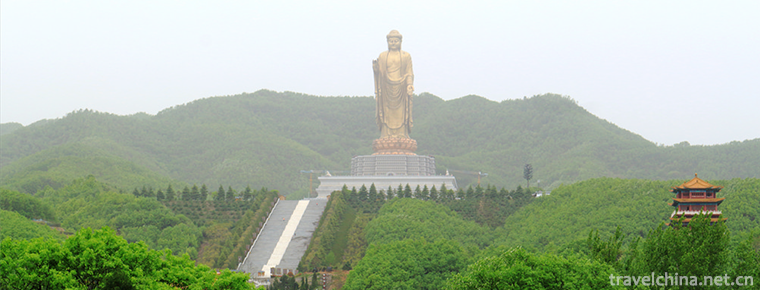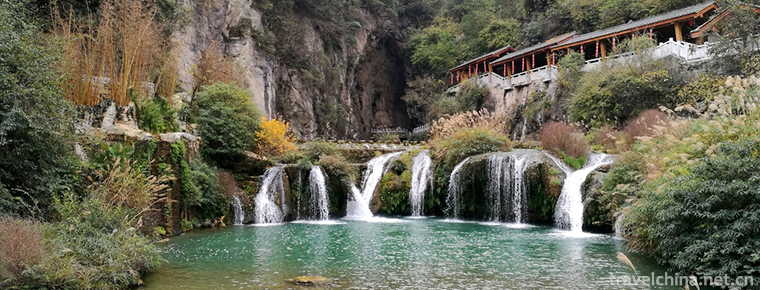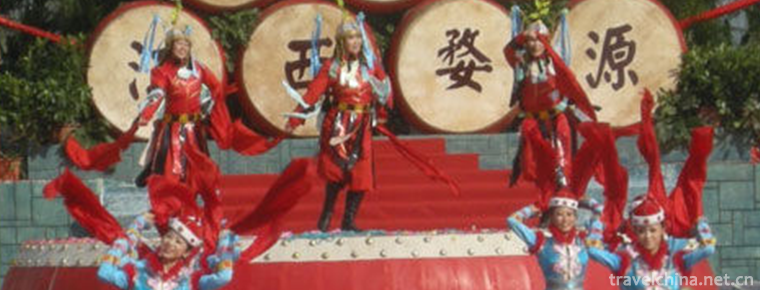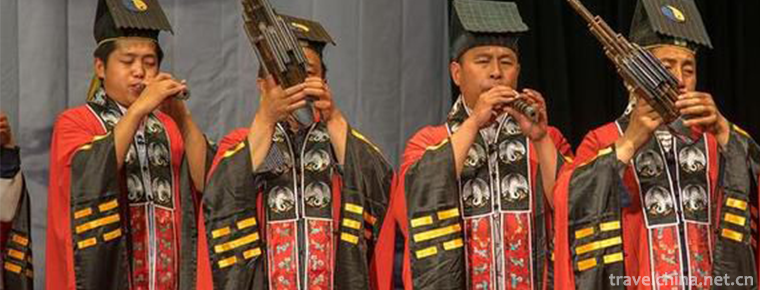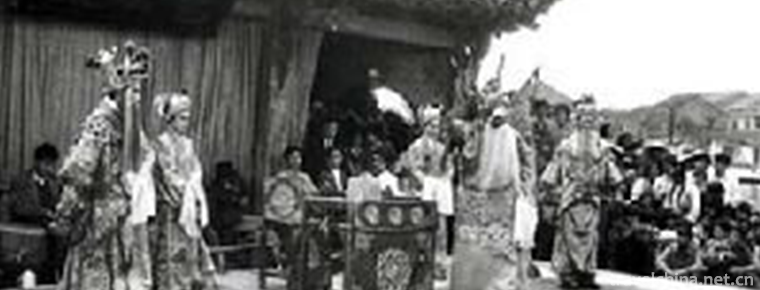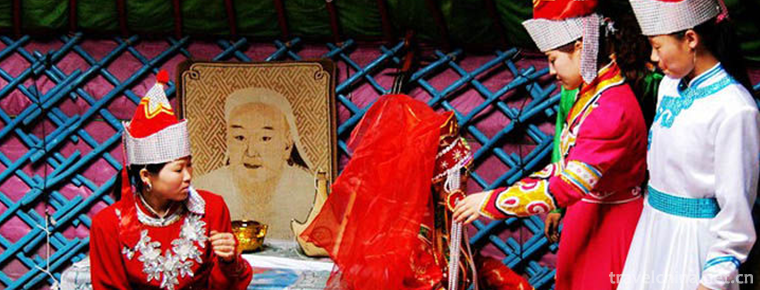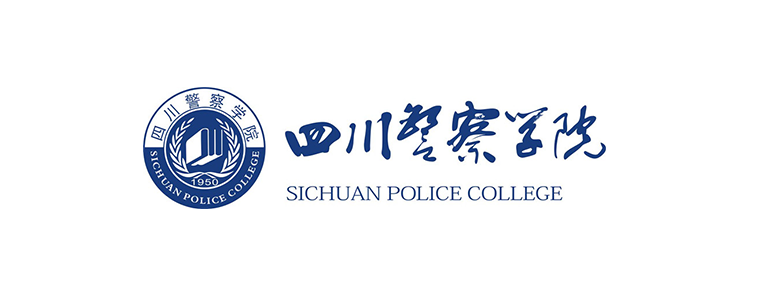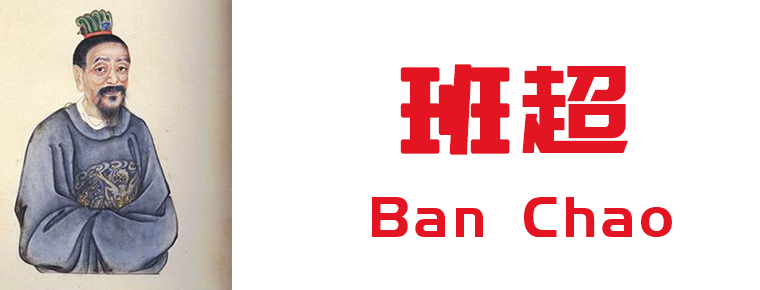Triple Drum Jump
Triple Drum Jump
Dancing three drums is a kind of opera which is popular in counties (cities) such as public security, Shitou, Jiangling and Songzi. It evolved from the funeral board and funeral drum song of sacrificing the dead in Jingchu area.
Main Forms
The singing form of three drums dancing is one of three people, mainly singing, speaking, singing and dancing. Speaking as an interlude in singing, dancing has its own characteristics. When performing, put a table and a stool, one person sitting on a drum to help the cavity, the other two singing in turn, with a one-sided cymbal festival, treading a rhythmic pace, advancing and retreating, face-to-face, back-to-back, excitement can also be big jump. The artist summarized his dancing movements as follows: "Right-handed chopsticks (sticks) left-handed cymbals, top-to-back T-shaped feet, three and a half steps, forward shuttle, back-to-back, brush past. They laugh at each other, you sing a song, I sing a song, the drum can not stop singing.
In the early years of the Republic of China, artists who danced three drums stepped out of Lingtang and entered tea clubs and bookstores for commercial performances, which greatly improved the repertoire.
History Origin
Because the Tujia people have the tradition of worshipping the white tiger as their ancestor and taking the white tiger as their totem, people have the idea of using the dance as a medium to lead the soul back to their ancestors in the sacrificial "dance of funeral drums". Therefore, in the dance, there are many imitations of tiger washing face, wagging tail, walking, predation and other movements. Especially when performing "Tiger Down Mountain", the performer leaps, holds, sucks legs, bends himself, then looks at each other, bumps elbows, and then jumps into a bow step. At the same time, the right arm turns around, and the mouth emits a burst of howling. The vivid image of the performer can be described as "Tiger Hunting".
In the performance of "funeral drum jumping", the core dance segments of "Big Four Step", "Big Four Gate", "Small Four Gate", "Funeral jumping" and "Shaking Funeral" all use the syncopated rhythm of 6/8 beats, i.e. three beats per step, full foot deep grasp, the first step, two or three beats shaking, two or three feet alternating, just like the attitude of a tiger steadily marching in the mountains. So "Dancing the funeral drum" is also known as "White Tiger Dance".
historical origin
The Tujia nationality's "Dancing the Drum" in the Tujia nationality area of the Qingjiang River Valley in northern Hunan Province, spreads a kind of unique ancient funeral folk song and dance, "Dancing the Drum", also known as "Dancing Salhao". In the Shanzhai village, no matter who old people died, it is necessary to invite the master to come home to play the funeral drum. That night, Suona played high, gongs and drums played loudly, firecrackers did not stop. At the sound of the drum, people from the neighbouring villages rushed to mourn.
The so-called "hears the drum, the footboard itches", "people lose their homes, one dozen drums and two help", "can not afford tofu to send emotions, dance a night of drum funeral to send the dead" and other statements, really reflects the Tujia people for the elderly to enter another world and the special emotional way of singing and dancing in mourning the dead, comforting the living. This kind of traditional funeral dance, which still preserves the legacy of ancient Bayu dance and bamboo branch ci, is contained in the Tang Dynasty's Manshu. It is still the most appropriate portrayal of "the parents'first funeral, drumming and mourning, singing and dancing".
In Tujia funeral custom, because Chuang Tzu is considered to be the ancestor of funeral drum beating, before performing the dance of funeral drum with a set of routines, a special drum beater must cooperate with the opening singer, and the opening ceremony should be a burst of drum beating and then drum beating. Then Chuang Tzu should be in place before starting.
Performance Content
"Dancing funeral drum" is a dance in front of the coffin by drum beaters, singers and dancers. Generally, double dancers with more than two dancers dance in front of the coffin. When they reach the climax, there are less than 100 dancers, and more than thousands of dancers can come to participate in dancing and watching. Dancers alternately appear until dawn before the end of the ceremony to deliver the singer and perform other ceremonies.
The "funeral drum dance" in funeral customs is entirely performed by men, but women can not be on the stage, but they can become professional spectators on the side and talk about the dancers'tastes or more, or secretly send autumn waves to the young men who are vigorous on the dance floor, causing a burst of applause and applause. Throughout the whole dance process, dancers danced with bare arms while drinking, fully demonstrating their masculine beauty. The form of "jumping funeral drum" is old and simple, relaxed and orderly. When it's hot, it's like a mountain wind whistling; when it's quiet, it's like a stream, which makes people feel agitated and lingering.
repertoire
The forms of "jumping funeral drum" are divided into "waiting for corpse", "shaking funeral", "crying", "wearing funeral", "practicing funeral" and "retreating funeral". The basic movements include "tiger holding his head", "rhinoceros looking at the moon", "phoenix spreading its wings", "swallow containing mud", "tiger descending the mountain" and more than a dozen routines.
Characteristic of performance
"Dancing funeral drums" can be divided into literary dance and martial dance, namely "literary funeral" and "martial funeral". "Wumourning" is a kind of jumping method combined with folk Wushu. Its basic movements include more than ten routines, such as "tiger holding head", "hitting people", "cattle scratching itch". It has a large range of movements and pays attention to vigorousness and ruggedness, so it is not competent for young descendants. It is mainly applicable to the funeral of the old people who walk along the footpath with their children and grandchildren in the hall, with the intention of congratulating them on their death. "Literary funeral" is characterized by "crying". The basic movements are mainly "four steps". However, the speed is slow, the lyrics are sad, the singing tone is sad, and the emotions can make people cry. Generally, it is only used in "juvenile death".
Another improvised "funeral dance", singing directly using folk tunes or self-made jokes slang, to drum tune, with extremely exaggerated clown action set off dance steps, humorous and interesting, very interesting. Especially in the second half of the night, when people are tired of spirit, they sing the "meat song" which mainly focuses on love and jokes, so as to turn the funeral into celebration.
The lyrics of "Dancing funeral drums" are very rich, including praise of Tujia ancestors'exploiting territory and recalling national history, reflection of ancestors' totem worship, fishing and hunting activities, agricultural production, love life, and singing the deeds of the dead, so it plays a vital role in the inheritance of Tujia culture.
There are Ancient Rhymes in the deep mountains, and funeral drums are a legacy. The powerful "Drum Dancing" strongly expresses the soul of the whole Tujia nationality, and creates a bold and happy nation that "starves to death for three years".
Performing Form
Wufeng funeral dance "Dance three drums" originally named "Dance three drums". In 1952, the funeral drum dance was renamed "Dance three drums" because it had three contents of "Congratulations on birthday, funeral drums and filial piety songs", and was named "Dance three drums" in 1983. Although it is interpreted as the proper name of "birthday celebration, drum mourning and filial piety song", three drums dancing is mainly performed in rural funeral.
The biggest difference between funeral drum dancing and triple drum dancing is "dancing". From music, dance to lyrics, funeral dancing has little sense of grief, high music and joy, and vigorous and brave steps. There are songs and dances in funeral dancing, and dancing is more important. The whole dance changes the playing card, rhythm and dance posture with the drums and singing tunes of the applauders.
Jumping three drums is only used in funerals with the Han nationality. Legend originates from Chuang Tzu's "song of drum basin". Three drums are performed by three or four people, singing separately and sitting singing separately. The standing singing is accompanied by one person beating drums and two people beating cymbals. There is an interlude between the main part of the song. After the drummer, the drummers beat the drums. The two actors each hold a cymbal (called "cymbals" in Shishou dialect), beat it with chopsticks and sing in rhyme. The cymbal is originally a magic weapon of witches. Its pronunciation is sad and harsh. It is transmitted in the cold night and the fresh wind, which makes people alert. Therefore, the triple drum dance itself has the function of exorcising ghosts and dispelling epidemics.
But in order to increase entertainment and attract audiences, the lyrics are also full of humorous elements. Their contents are very wide. The life stories of the deceased, historical legends and daily life are all the subjects of singing. The lyrics are mostly four sentences and seven words, one rhyme to the end, maintaining the metrical form of some ancient music cards. After each song, the two singers swap positions, which is probably the change of the dance.
Source area
The first batch of provincial intangible cultural heritage lists in Hubei Province ranked on the three drums list of Shishou Jump.
There are 98 items in the first batch of provincial directories and 7 items in Jingzhou. These cultural heritages are primitive, have been spread among the people and have unique artistic styles.
Triple Drum Dance Association was formally established on April 19, 2006. Zhao Zhizhong, a villager of Beihekou Village, Tuanshan Temple Town, Shishou City, was the chairman of the association. Triple Drum Dance was listed as one of the first provincial intangible cultural heritage lists in Hubei Province. It is widely expected that this kind of intangible cultural heritage with a long history and strong local flavor and folk art will revive.
External Development
The funeral of the Gutu people was very lively. "Joyful death and funeral" fully reflects Tujia's open-minded outlook on life and death. In the Shanzhai village, no matter who old people die, the singer must be invited to play the funeral drum.
That night, Suona played high, gongs and drums played, firecrackers burst. When the drum sounded, several villages came to mourn. The so-called "hears the funeral drum sound, the footboard itches, the dead people mourn, does not invite oneself to come". The dancers in the spiritual hall each carry a musical instrument and are directed by the applause master. Together with the drums, the mourners, in groups, step on the drums, sing together and dance in the spiritual hall, which is called "funeral dance".
The tunes of the funeral songs include dozens of cards, such as "Saerhao", "Call Song", "Shake the funeral", "General's Order", "Zhenggong Tune", "One Word", "Festival High", "Crab Song", and so on, with lively rhythm and warm atmosphere; the lyrics include singing praises for the dead, love, history, allusions, and moving singing. Animals and plants, there are riddles, the content is very rich.
Tu Teacher also advised the world that even your generals and emperors would inevitably be buried in the earth, even if you had a high official and a good salary, it was just a grave coffin. Tujia people jump to mourning, one sings praises for the deceased, and the other comforts the deceased's family members. Everyone regards "jumping to mourning" as a symbol of friendship, saying, "You can't afford to give money without a rake, and jump to mourning overnight to give people love." "Dance and funeral" has a relationship with Ba people's music and dance.

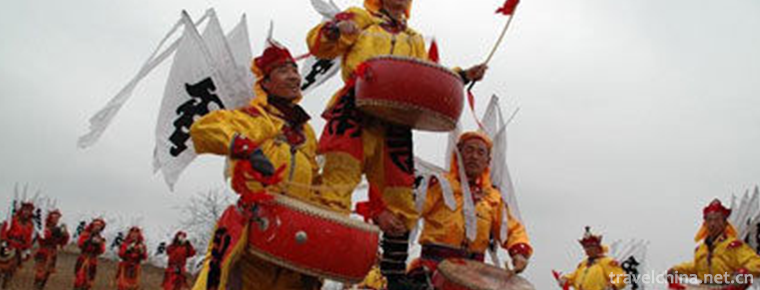
-
Zhongyuan Great Buddha Scenic Area
The Central Plains Buddha, located in Shangtang Foquan Temple, Zhaocun Township, Lushan County, Pingdingshan City, Henan Province.
Views: 180 Time 2018-12-09 -
Mount Danxia Scenic Area
Danxia Mountain Scenic Area is located in Renhua County, northeast of Shaoguan, Guangdong Province. Danxia Mountain is composed of red sandy scintillate rocks and characterized by red cliffs. Geologis.
Views: 148 Time 2018-12-12 -
Liaoheyuan National Forest Park
Liaoheyuan National Forest Park is located in Dawopu Forest Farm, Pingquan County, Hebei Province. It is named for its birthplace of Liaohe River in China..
Views: 146 Time 2019-01-30 -
Tianhetan Scenic Area
Tianhetan is located in Shibanzhen, Huaxi District, Guiyang City, Guizhou Province. It is a scenic spot with typical karst natural scenery as the main part and historical celebrities.
Views: 117 Time 2019-02-21 -
Changshan Cheerful Ballads
In Changshan, the custom of applauding when marrying and bridging a new house has been popular among the people since ancient times for the sake of luck. The content of applause for marriage.
Views: 380 Time 2019-04-16 -
Drum Dance
Dance and drum dance is a kind of folk dance of Miao nationality in China. Miao people's "encouragement" has a long history. The written records of Miao people's drumming.
Views: 130 Time 2019-05-01 -
Sheng Guanyue in Jizhong
Jizhong Sheng wind music is popular in Jizhong Plain, that is, south of Beijing, west of Tianjin, north of Cangzhou and Dingzhou frontline nearly 30 counties and cities of traditional drum music varie.
Views: 303 Time 2019-05-05 -
Lingqiu Luoluo Tune
Lingqiu Luoluo Opera evolved from Yiyang Opera and flourished during Qianlong Period of Qing Dynasty. From the end of Qing Dynasty to the Republic of China, it gradually declined. Luoluo tune is sung .
Views: 370 Time 2019-05-13 -
Mongolian Wedding
Mongolian young men and women marry on auspicious days, and men give gifts to women's homes. The gifts include cash, clothes, cloth, jewelry, rice and so on. There are cabinets, bedding, clothes, jewe.
Views: 141 Time 2019-06-03 -
Sichuan Police College
Sichuan Police College is the only full-time undergraduate college of political, legal and public security in Sichuan Province, which is sponsored by the People's Government of Sichuan Province and jo.
Views: 118 Time 2019-08-31 -
Ban Chao
Ban Chao (32 - 102 years), the word Zhong Sheng. Fufeng County Ping Lingxian County (now) Shaanxi People in Northeast Xianyang. Eastern Han Dynasty Famous time Militarist Diplomats, historian Ban Bi T.
Views: 224 Time 2019-09-06 -
Luzhou Medical and health
By the end of 2018, there were 46 primary health institutions and 39 other health institutions in the city, including 46 primary health institutions and 1 professional health institution. Among the hospitals, there are 97 general hospitals, 15 TCM hospitals and 35 specialized hospitals.
Views: 119 Time 2020-12-14
